Fra Bartolommeo, born Baccio della Porta, stands as a significant master of the Italian High Renaissance, a period of extraordinary artistic flourishing. Active primarily in Florence, his work embodies the transition from the more delicate and linear qualities of the Early Renaissance to the monumentality, idealized naturalism, and harmonious compositions that defined the subsequent era. A devout Dominican friar, his deep religious convictions profoundly shaped his artistic output, leading him to specialize almost exclusively in sacred subjects. His paintings are celebrated for their serene grandeur, masterful handling of light and shadow (chiaroscuro), rich color palettes, and the dignified, human emotion conveyed by his figures. Fra Bartolommeo's art not only reflects his personal piety but also the complex interplay of religious fervor and artistic innovation that characterized Florence at the turn of the 16th century.
Early Life and Artistic Formation
Baccio della Porta was born on March 28, 1472, in Tuscany, either in Savignano di Prato or the nearby Soffignano. His father, Paolo, was a muleteer, a humble background for a future artistic luminary. This origin, however, did not impede his access to artistic training. By 1484, at the young age of twelve, Baccio was apprenticed to the workshop of Cosimo Rosselli in Florence. Rosselli was a respected painter, known for his participation in the fresco decoration of the Sistine Chapel walls, alongside artists like Sandro Botticelli, Pietro Perugino, and Domenico Ghirlandaio.
In Rosselli's workshop, Baccio would have received a thorough grounding in the techniques of Florentine painting, including drawing, panel painting, and fresco. It was here that he formed a close friendship and artistic partnership with Mariotto Albertinelli, another apprentice. Their collaboration would become a defining feature of Baccio's early career. Together, they absorbed the artistic currents of late 15th-century Florence, a city teeming with innovation. The influence of masters like Leonardo da Vinci, with his revolutionary use of sfumato and psychological depth, and Perugino, known for his sweet-faced Madonnas and spacious compositions, began to permeate the artistic environment, and Baccio was undoubtedly receptive to these developments.
The Influence of Savonarola and Spiritual Transformation
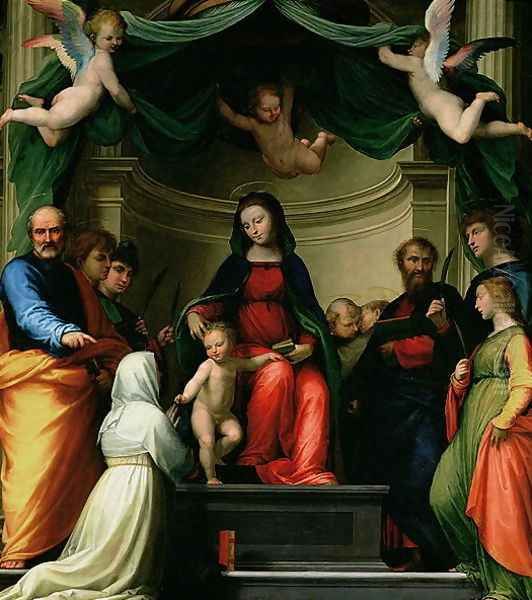
The late 1490s in Florence were dominated by the charismatic and fiery Dominican friar, Girolamo Savonarola. Preaching vehemently against the perceived moral corruption and pagan influences within the Church and society, Savonarola called for religious and social reform. His sermons had a profound impact on the Florentine populace, including many artists. Baccio della Porta was deeply moved by Savonarola's teachings, becoming one of his devoted followers, or "Piagnoni" (weepers).
This spiritual awakening had a dramatic effect on Baccio's life and art. Savonarola condemned art that he deemed worldly or licentious, advocating instead for art that served a purely didactic and devotional purpose. Famously, he instigated the "Bonfire of the Vanities" in 1497, where citizens burned objects considered temptations to sin, including secular books, luxurious clothing, and artworks deemed inappropriate. It is recorded that Baccio, in a display of his fervent piety, consigned his own drawings and paintings of secular or mythological subjects to the flames. This act underscored his commitment to Savonarola's vision of a purified Christian art.
Following Savonarola's excommunication and execution in 1498, Baccio's religious convictions only deepened. On July 26, 1500, he took a momentous step, renouncing his secular life and entering the Dominican Order at the convent of San Domenico in Prato. He adopted the name Fra Bartolommeo, "Brother Bartholomew." For a period of about four years, he largely abandoned painting, dedicating himself to monastic life. This hiatus, however, was not to be permanent.
Return to Painting and the San Marco Workshop
The call to create art proved too strong for Fra Bartolommeo to ignore indefinitely. Encouraged by his superiors, notably Sante Pagnini, the prior of the convent of San Marco in Florence (to which Fra Bartolommeo had transferred in 1501), he resumed his artistic activities around 1504. San Marco itself had a rich artistic heritage, famously associated with the devotional frescoes of an earlier Dominican painter, Fra Angelico, whose serene and spiritual works undoubtedly provided inspiration for Fra Bartolommeo.
Upon his return to painting, Fra Bartolommeo established a workshop within the San Marco convent. He re-established his partnership with Mariotto Albertinelli around 1509, a collaboration that lasted until 1513. Albertinelli, who had continued painting during Fra Bartolommeo's monastic retreat, brought a complementary skill set, and their joint workshop produced numerous significant altarpieces. This period marked a new phase in Fra Bartolommeo's artistic development, where his profound spirituality was channeled into creating works of serene majesty and devotional power. His paintings from this era began to exhibit the hallmarks of the High Renaissance style, characterized by balanced compositions, idealized figures, and a sophisticated use of color and light.
Artistic Development: Early Influences and Collaborations
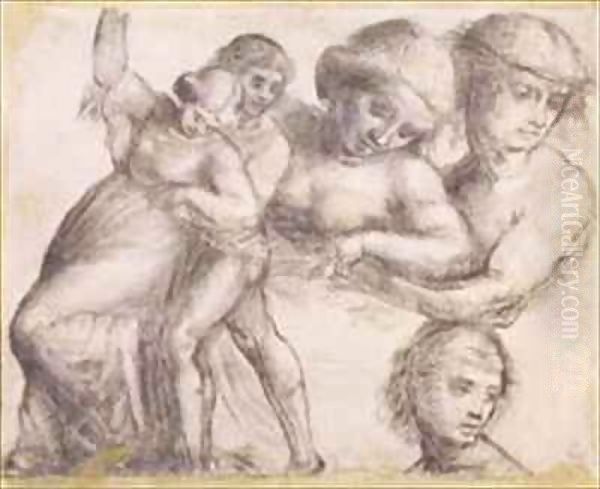
Fra Bartolommeo's early artistic style, before his monastic vows, was shaped by the prevailing Florentine traditions and his collaboration with Mariotto Albertinelli. Their joint works often make it difficult to distinguish individual hands, but they generally show a solid understanding of form and a tendency towards gentle, devotional expressions. An early significant commission was the fresco of the Last Judgment (1499-1501) for the cemetery of the hospital of Santa Maria Nuova in Florence. Though Fra Bartolommeo left it unfinished when he entered the monastery (Albertinelli completed it), the surviving portions and preparatory drawings reveal his early grasp of complex figural arrangements and dramatic narrative, influenced by artists like Luca Signorelli, whose own Last Judgment frescoes in Orvieto Cathedral were contemporary.
The influence of Leonardo da Vinci is discernible in Fra Bartolommeo's subtle modeling of forms and his use of sfumato, the soft blending of tones to create an atmospheric effect. This is particularly evident in the gentle expressions and softly rendered flesh of his Madonnas and saints. Pietro Perugino's influence can be seen in the sweetness of his figures and the clarity of his compositions, often featuring serene landscapes. Works like the Annunciation (c. 1497, Volterra Cathedral), a collaborative piece with Albertinelli, showcase these early tendencies, with its balanced composition and graceful figures.
The Impact of High Renaissance Masters: Rome and Venice
A pivotal moment in Fra Bartolommeo's artistic evolution was his journey to Venice in 1508. There, he encountered the rich, color-driven art of the Venetian school, particularly the work of Giovanni Bellini. Bellini's mastery of luminous color and atmospheric effects left a lasting impression on Fra Bartolommeo, whose own palette subsequently became warmer and more vibrant. This Venetian influence added a new dimension of richness and sensuousness to his inherently Florentine emphasis on drawing and form (disegno).
Perhaps even more transformative was his visit to Rome, likely around 1513-1514. In Rome, Fra Bartolommeo came face-to-face with the monumental achievements of the High Renaissance masters, Michelangelo and Raphael. Michelangelo's powerful, dynamic figures in the Sistine Chapel ceiling and Raphael's harmonious and graceful compositions in the Vatican Stanze profoundly impacted him. He absorbed their lessons in grandeur, compositional complexity, and idealized human form. This Roman experience pushed Fra Bartolommeo's art towards a greater monumentality and a more classical sense of balance and proportion, fully aligning him with the High Renaissance aesthetic. He reportedly formed a friendship with Raphael, and there was a mutual exchange of artistic ideas; Vasari notes that Raphael learned from Fra Bartolommeo's use of color and drapery, while Fra Bartolommeo benefited from Raphael's understanding of perspective and composition.
Mature Style and Major Altarpieces
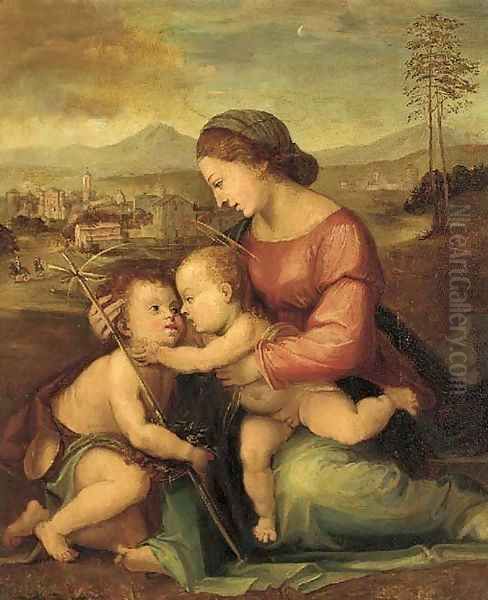
Following his experiences in Venice and Rome, Fra Bartolommeo's style reached its full maturity. His paintings from this period are characterized by their imposing scale, solemn dignity, and masterful synthesis of Florentine design with Venetian color. He excelled in creating "Sacra Conversazione" (sacred conversation) altarpieces, depicting the Virgin and Child enthroned among saints. These works are notable for their pyramidal compositions, a hallmark of High Renaissance design, which lend stability and harmony to the scene.
One of his most celebrated works from this period is the Mystic Marriage of St. Catherine of Siena (1511, originally for San Marco, now in the Louvre, Paris). This large altarpiece displays a complex yet perfectly balanced arrangement of figures, rich, glowing colors, and a profound sense of spiritual intensity. The figures are monumental and idealized, yet they retain a human warmth and tenderness. The interplay of light and shadow is masterfully handled, creating a sense of volume and drama.
Another key work is the Pala Pitti or Salvator Mundi with Four Evangelists (1516, Palazzo Pitti, Florence). This altarpiece, with its commanding figure of Christ as Salvator Mundi surrounded by the Evangelists, showcases Fra Bartolommeo's ability to convey spiritual authority and divine majesty. The figures are powerfully modeled, and the composition is both grand and intimate. The rich reds, blues, and golds contribute to the painting's solemn splendor.
His Vision of St. Bernard (c. 1504-1507, Uffizi, Florence) is an earlier but significant work that already demonstrates his capacity for conveying mystical experience with quiet intensity. The gentle interaction between the Virgin and the kneeling saint is rendered with great sensitivity. The Pietà (c. 1511-1512, Palazzo Pitti, Florence) is another powerful example of his mature style, conveying deep pathos through the restrained grief of the figures and the somber, atmospheric lighting.
Other notable works include the Madonna della Misericordia (Madonna of Mercy, 1515, Museo di Villa Guinigi, Lucca), where the Virgin shelters a group of devotees under her expansive cloak, a traditional motif handled with High Renaissance grandeur. The Assumption of the Virgin (c. 1516, Museo di Capodimonte, Naples) is another large-scale altarpiece demonstrating his compositional skills and rich colorism.
Themes and Artistic Characteristics
Fra Bartolommeo's oeuvre is overwhelmingly religious, reflecting his Dominican identity and the spiritual climate of his time. His primary subjects were Madonnas with Child and Saints, Annunciations, Holy Families, Pietàs, and scenes from the lives of saints. He avoided mythological or overtly secular themes, especially after his conversion under Savonarola's influence.

His figures are typically characterized by their monumentality and idealized beauty, yet they are imbued with a gentle humanity and psychological presence. He paid great attention to drapery, rendering it with voluminous folds that enhance the three-dimensionality and dignity of his figures. His use of chiaroscuro, influenced by Leonardo, was sophisticated, creating soft transitions and a sense of atmosphere. His color palette, initially more subdued, became richer and more vibrant after his Venetian visit, often employing deep reds, blues, and warm golds.
Compositionally, Fra Bartolommeo favored balanced, harmonious arrangements, often employing pyramidal structures. He was adept at managing large groups of figures, creating a sense of order and clarity even in complex scenes. His drawings, many of which survive, reveal his meticulous preparatory process and his skill as a draftsman. He often used lay figures (manichini) draped with cloth to study the fall of light and the arrangement of drapery, a practice that contributed to the realism and grandeur of his painted figures.
Collaborations, Workshop, and Influence
The workshop system was central to Renaissance art production, and Fra Bartolommeo was no exception. His most significant and enduring collaboration was with Mariotto Albertinelli. They shared a workshop before Fra Bartolommeo joined the Dominican order and resumed their partnership from around 1509 to 1513. Their joint signature appears on several works, and their styles were often closely intertwined. Albertinelli's more robust and sometimes less refined style complemented Fra Bartolommeo's grace. Works like the Assumption of the Virgin (c. 1508, Gemäldegalerie, Berlin) are products of this renewed collaboration.
Fra Bartolommeo also had pupils and assistants in his San Marco workshop, including Fra Paolino da Pistoia, who inherited his master's drawings and continued his style, and Giovanni Antonio Sogliani. Through his workshop and his own prominent commissions, Fra Bartolommeo exerted a considerable influence on the next generation of Florentine painters.
His impact can be seen in the work of Andrea del Sarto, who, while developing his own distinct style, absorbed lessons from Fra Bartolommeo's monumentality and colorism. Raphael, as mentioned, also engaged in a fruitful artistic dialogue with him. Other contemporaries in Florence included Franciabigio, Ridolfo Ghirlandaio (son of Domenico Ghirlandaio), and Jacopo Pontormo, who, though moving towards Mannerism, would have been aware of Fra Bartolommeo's authoritative High Renaissance style. Even earlier masters like Filippino Lippi and Lorenzo di Credi were part of the artistic milieu from which Fra Bartolommeo emerged and with whom his work can be compared and contrasted. The legacy of Fra Angelico, his Dominican predecessor at San Marco, provided a spiritual and artistic lineage that Fra Bartolommeo consciously built upon.
Anecdotes and Personal Life
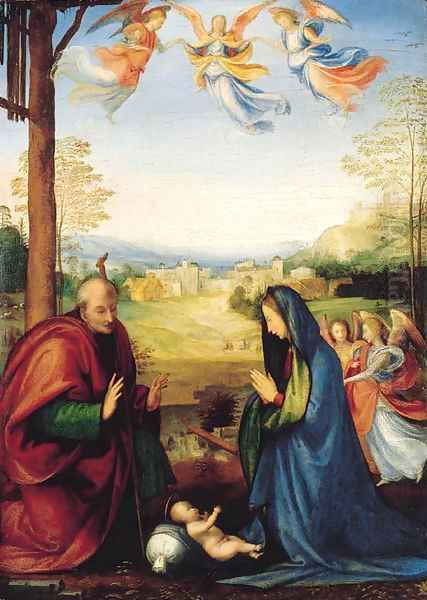
Giorgio Vasari, in his "Lives of the Artists," provides some insights into Fra Bartolommeo's personality and life, though these accounts should be approached with the understanding that Vasari sometimes embellished his narratives. He describes Fra Bartolommeo as a gentle, somewhat melancholic, and deeply pious man.
The story of him burning his secular drawings at the behest of Savonarola is a powerful testament to his religious fervor. Vasari also notes his dedication to his craft, including his innovative use of wooden lay figures with articulated joints to study drapery, which allowed for greater naturalism and complexity in his painted garments.
Regarding his health, Vasari mentions that Fra Bartolommeo suffered from ill health, possibly exacerbated by his intense work. He was said to be particularly fond of fruit, especially figs, and Vasari suggests that an overindulgence in figs during a hot summer contributed to a fever that ultimately led to his death. While the exact cause is uncertain, it's clear his life was relatively short.
His friendship with Raphael is another notable aspect of his personal connections. Their mutual respect and artistic exchange highlight the collaborative and competitive spirit of the High Renaissance, where artists learned from and challenged one another.
Later Years, Death, and Legacy
Fra Bartolommeo continued to paint actively in his later years, producing some of his most accomplished works. He remained based at the convent of San Marco, fulfilling commissions for churches in Florence and other Italian cities. His reputation as one of Florence's leading painters was firmly established.
However, his career was cut short by his premature death. Fra Bartolommeo passed away in Florence on October 31, 1517, at the age of 45. He was buried in the convent of San Marco, the spiritual and artistic home of his later years.
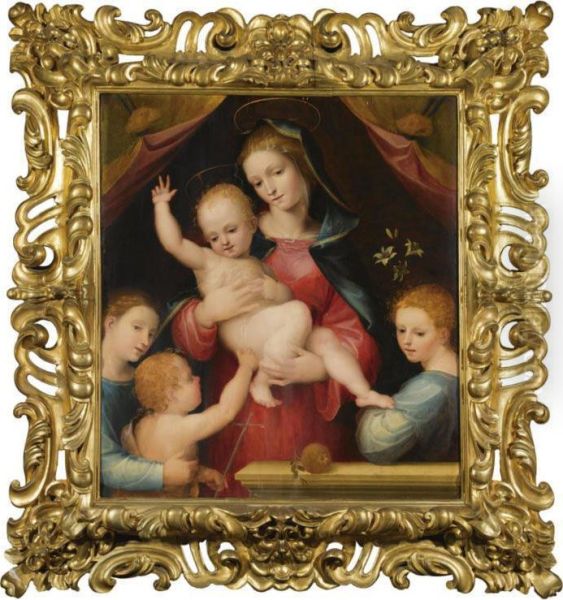
Despite his relatively short life, Fra Bartolommeo left a significant mark on Florentine art. He was a key figure in the development of the High Renaissance style in Florence, successfully integrating the innovations of Leonardo, Michelangelo, and Raphael, as well as the coloristic richness of Venetian painting, into a personal style characterized by serene grandeur and deep spirituality. His altarpieces became models for subsequent religious painting, and his influence extended through his pupils and contemporaries. He demonstrated that profound religious conviction could coexist with, and indeed inspire, the highest levels of artistic achievement, creating works that continue to resonate with their quiet power and devotional intensity. His legacy is that of a master who perfectly balanced spiritual depth with the artistic ideals of the High Renaissance.
Conclusion
Fra Bartolommeo's journey from Baccio della Porta, the muleteer's son, to a revered Dominican friar and a leading master of the Florentine High Renaissance is a compelling story of artistic talent and profound faith. His work stands as a testament to the spiritual and aesthetic currents of his time, embodying a harmonious fusion of idealized beauty, compositional order, and deep religious sentiment. Influenced by the giants of his era like Leonardo da Vinci, Michelangelo, and Raphael, and in turn influencing others like Andrea del Sarto, he carved out a distinct and respected place in the history of art. His altarpieces, with their monumental figures, rich colors, and serene dignity, remain powerful expressions of Christian devotion and High Renaissance artistic principles, securing his position as an indispensable link in the great chain of Italian Renaissance painters.